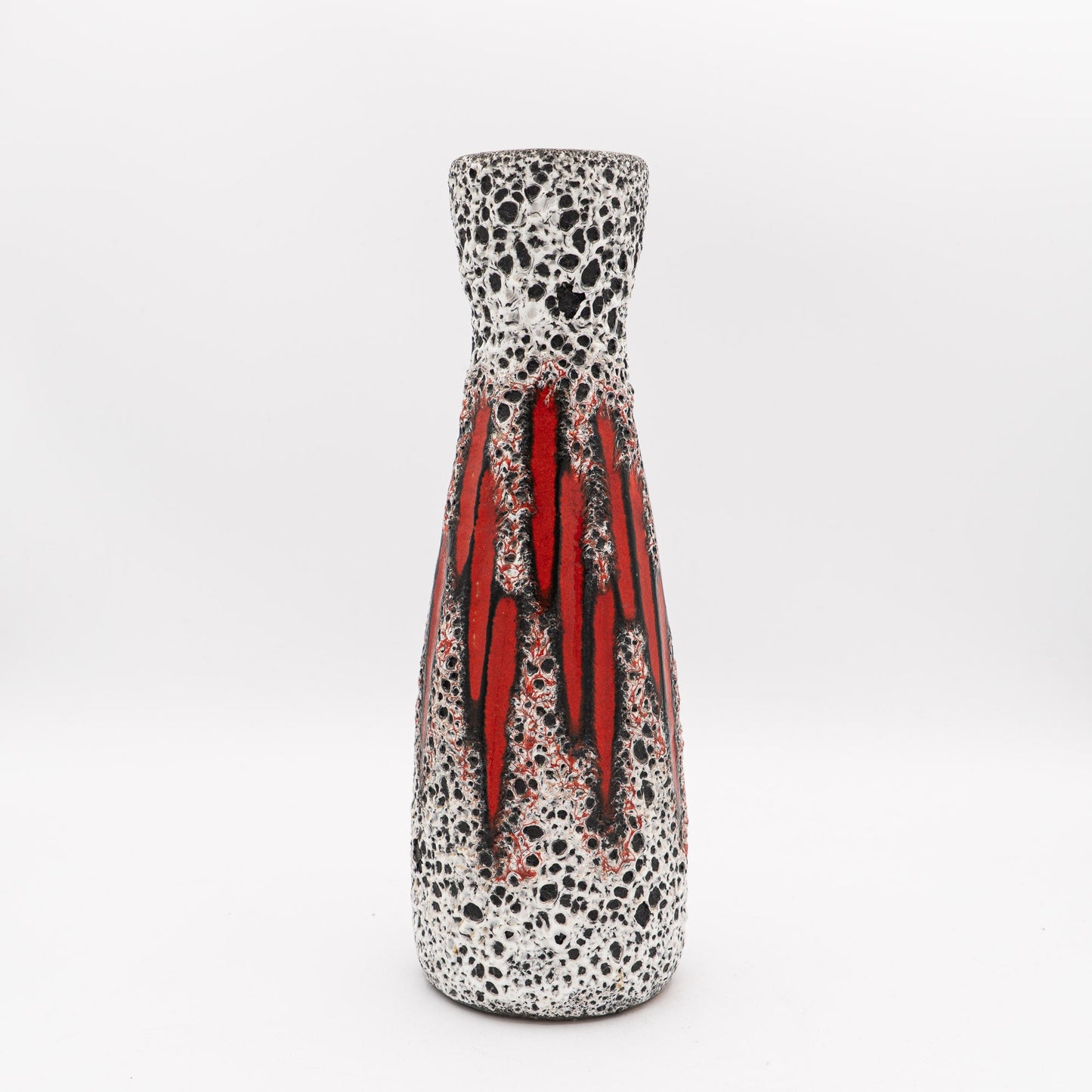Scheurich
Mid-Century "Lora" - Scheurich 520-28 - 1970s
Mid-Century "Lora" - Scheurich 520-28 - 1970s
Couldn't load pickup availability
A true star of West German pottery, this Scheurich “Lora” 520-28 commands the room with a foamy black-and-white crater ground cut through by molten red flows.
The tall, tapering silhouette (shape 520) shows the glaze to perfection: tactile, volcanic, and wildly graphic. Made in the 1970s, it’s exactly the kind of statement piece collectors hunt for - equally striking solo or grouped with other fat-lava forms.
“Lora” is the pattern name for a Scheurich glaze family characterised by a speckled/crater base - usually white over black - with dramatic, glossy red (sometimes orange) lava runs.
Produced in the late 1960s–70s across many shapes and sizes (e.g., 242, 269, 408, 517, 520), the series is prized for its high contrast, heavy texture, and unmistakable “volcanic” theatre. No two examples are quite the same, which keeps the hunt exciting.
- Material: Stoneware with thick fat-lava/crater glazes
- Maker: Scheurich Keramik
- Motif: “Lora” volcanic crater with red lava runs
- Style: Mid-Century Modern / West German Pottery (WGP)
- Place of Origin: West Germany
- Mark: Impressed “520-28” to base (typical Scheurich shape/height code)
- Date of Manufacture: 1970s
-
Condition: Very good vintage; see photos and notes above
Dimension:
Height: 28 cm | 11 in
Share
- Worldwide Shipping
- Secure Packaging
- Loving Curation






Origin & Maker
Scheurich, one of the most prominent names in West German pottery, was founded in 1928 and rose to fame during the mid-20th century. Known for its production of affordable yet high-quality ceramics, the company became a key player in the "Fat Lava" movement of the 1960s and 70s, characterised by bold textures and glazes. Scheurich’s extensive range of forms and designs, such as the popular "Form 242," showcased both hand-painted and moulded motifs, appealing to a wide audience. Their use of vivid colours, tactile surfaces, and intricate glazes made their pieces highly collectible today. Among their distinctive works, many vases, planters, and jugs are finished with deep, volcanic-like textures, giving them a timeless appeal.
One of the reasons for Scheurich's enduring success was their ability to innovate while maintaining affordability. Their design approach often drew inspiration from nature, incorporating organic shapes and motifs, with some pieces reminiscent of majolica in their glaze techniques. The company remains a celebrated name among collectors of mid-century and West German pottery, with many pieces, especially from the "Fat Lava" era, still in high demand.
Blog posts
View all-

A Serendipitous Morning at the Rue de Bretagne ...
There are few joys in life that match the thrill of stumbling upon a hidden treasure, and for me, flea markets hold that magical allure. One of my favourite flea...
A Serendipitous Morning at the Rue de Bretagne ...
There are few joys in life that match the thrill of stumbling upon a hidden treasure, and for me, flea markets hold that magical allure. One of my favourite flea...
-

Emile Bourgeois and "Le Grand Dépôt" in Paris
Recently, I found this stunning Sarreguemines wash set. It was at the Brocante in Belfort, France. On this day, we had got up at 4 AM to be there in...
Emile Bourgeois and "Le Grand Dépôt" in Paris
Recently, I found this stunning Sarreguemines wash set. It was at the Brocante in Belfort, France. On this day, we had got up at 4 AM to be there in...
-

The Legacy of Robert Haviland: A Journey from N...
The story of Robert Haviland porcelain is one of artistry, transatlantic ambition, and enduring heritage. It begins in the mid-19th century when David Haviland, an enterprising New Yorker, founded Haviland...
The Legacy of Robert Haviland: A Journey from N...
The story of Robert Haviland porcelain is one of artistry, transatlantic ambition, and enduring heritage. It begins in the mid-19th century when David Haviland, an enterprising New Yorker, founded Haviland...









